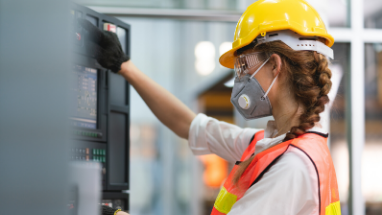The current COVID-19 crisis has impacted almost every industry worldwide, forcing businesses to implement work from home strategies, discontinue travel, and scale back on operations. Industrial and manufacturing businesses have been particularly affected by this due to reduced frontline worker availability, supply chain issues and the need to create social distancing workplaces for the health […]
The current COVID-19 crisis has impacted almost every industry worldwide, forcing businesses to implement work from home strategies, discontinue travel, and scale back on operations. Industrial and manufacturing businesses have been particularly affected by this due to reduced frontline worker availability, supply chain issues and the need to create social distancing workplaces for the health and safety of workers while also keeping them connected.
But in an industry that relies on the bulk of its operations to be carried out on-site, how can manufacturing businesses remain at capacity and keep frontline workers engaged during a time of remote working and travel restrictions?
According to Forbes, many leading manufacturing businesses are looking to Connected Worker technology to help manage these issues and keep up with operations. Through the use of augmented reality (AR) combined with artificial intelligence and machine learning (AI/ML), a connected worker platform allows manufacturers to take advantage of digital information to carry out tasks on site and complete jobs. Here are 3 major ways connected worker technology is helping keep manufacturing businesses stay afloat during COVID-19:
- Flexible work arrangements that support social distancing
As a result of COVID-19, manufacturers have initiated policies that encourage remote working, eliminate non-essential travel and instruct employees who are sick to stay home until they are better. This directly impacts the progression of operations that typically take place when multiple workers collaborate onsite. With on-demand remote expert functionality, onsite workers can quickly pull in an offsite colleague when their expertise is required. Procedures, videos, real-time data and more are readily available to intelligently guide and help workers on the job. - Reduced complexity and downtime
Manufacturers can expect a learning curve as they assess strategies and implement new ways to work more at home and less on the shop floors. Using a connected worker platform allows companies to pivot quickly in order to retain the workforce and reduce downtime during learning periods. Frontline workers are able to receive fully augmented, guided instructions on any device to improve productivity, quality and customer satisfaction. - Gather insightful data to track progress during the crisis with AI
It’s critical for manufacturers to monitor processes and track progress during this time so that they can make quick adjustments to ensure overall optimization. Incorporating AI into an AR strategy goes one step further by enabling true organizational optimization using the rich stream of activity data to recommend improvement actions to frontline workers, continuous improvement specialists, trainers, manufacturing engineers, and operation and service managers.
As this pandemic crisis continues to spread worldwide, manufacturers will likely continue to face challenges and look to connected worker technology to keep their workers safe and their businesses operating. It’s also important to recognize this as a major turning point in the way frontline workers interact and perform daily operations in the future.

